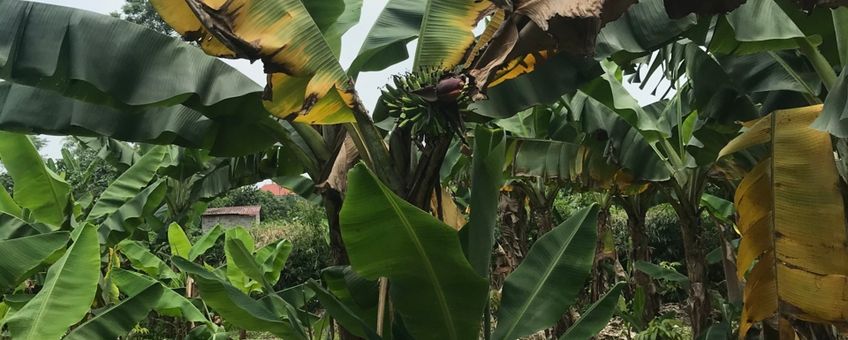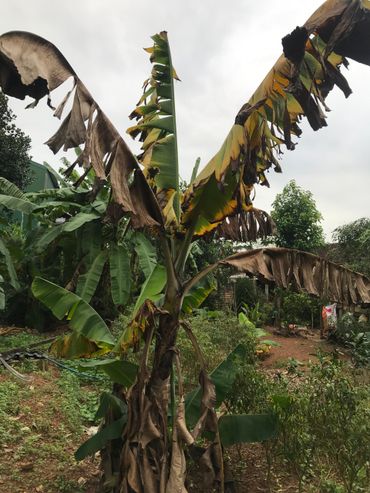
Fungal pandemic threatens Vietnamese banana production
Naturalis Biodiversity Center
Due to a new race of the fungus Fusarium oxysporum f. sp. cubense (FOC), an FOC pandemic threatens to hit banana production. Belgian and Vietnamese researchers found this new FOC-TR4 race on banana plantations in Vietnam. This has major consequences for the local economy and the worldwide banana export.
Fusarium wilt
New FOC races, in particular, pose a major threat for worldwide banana production, such as FOC-TR4 that severely damages bananas and causes wilting. The fungus spreads through the soil and infects the roots of various crops, including banana plants. It subsequently grows further into the plant to the vascular system. As a result of this, the plant gradually deteriorates and eventually dies. What makes this fungus particularly persistent is that FOC spores can remain dormant in the soil for twenty years after the infected plants have been removed. This causes newly planted crops to become infected, even if all the infected plants have been removed for a long time.
Not a new problem
This is not the first time that FOC has caused problems. We all eat virtually the same bananas, as more than half of the worldwide banana production depends on one specific banana cultivar: the Cavendish banana. Until the 1950s, the predominant cultivar was the Gros Michel. A certain FOC race infected all Gros Michel bananas so badly that almost the entire production was stopped. Older readers might remember the song ‘Yes, we have no bananas’, which is about a banana shortage caused by Fusarium.
Yes! We have no bananas by Ben Selvin (Source: the78prof)
Cavendish bananas
Banana production then switched from Gros Michel to Cavendish bananas, because these did not become diseased from FOC. However, that is now history: the new FOC-TR4 race can infect Cavendish bananas. As a result of this, many Cavendish banana plants are becoming infected, and worldwide banana production is falling, especially in Vietnam.
New banana cultivar
If FOC-TR4 threatens to infect all Cavendish banana plants, we will need to search for a new banana cultivar, just like in the 1950s. The most important requirement is that this cultivar does not become infected by FOC-TR4, nor other FOC races. There are undoubtedly wild banana cultivars with that characteristic, but consumers obviously want to have a banana like the one they know: with the same taste, size, and structure as the Cavendish. Finding such a banana is the current challenge.
We are the cause of the problem
 This does not solve the problem. The cycle will continue to repeat: a new fungal race will infect the banana, a new banana cultivar will have to be found that is resistant to this fungus and that new cultivar can, in turn, be infected by yet another fungal race.
This does not solve the problem. The cycle will continue to repeat: a new fungal race will infect the banana, a new banana cultivar will have to be found that is resistant to this fungus and that new cultivar can, in turn, be infected by yet another fungal race.
Vincent Merckx, a mycologist at Naturalis and the University of Amsterdam, explains how this cycle arose: “The problem lies in how we produce bananas. The worldwide banana production consists of exact clones of banana plants that are grown in large monocultures. This means that all plantations only contain banana plants and no other crops. Therefore, only one specific fungal race is needed which will then be able to infect not just one plant but all plants. This makes the banana industry extremely sensitive to diseases, and we are currently noticing the consequences of that.”
Research in Vietnam
As banana producers are suffering from ever larger losses as a result of FOC, it is becoming increasingly important to know which FOC races are causing this wilting in Vietnamese bananas. An international team of experts from the Vietnamese National Agricultural University, Meise Botanic Garden, KU Leuven, and Naturalis investigated which FOC races occur most commonly in Northern Vietnam. Meise Botanic Garden in Belgium has investigated bananas for many years and works closely with the KU Leuven, which houses the world’s biggest collection of living banana plants. Together with researchers from Naturalis, they investigated diseased banana plants from nineteen different locations in Vietnam.
Of all the wilted plants investigated, only ten percent was infected with the FOC-TR4 race. Depending on soil conditions, the TR4 race could spread across Vietnam and become the dominant race. As FOC-TR4 infects not only the Cavendish variety but also wild banana species, wild bananas could ensure a faster spread of FOC.
Are the Cavendish bananas in danger?
If FOC-TR4 continues spreading, it could infect nearly all Cavendish bananas, as previously happened with the Gros Michel. Merckx says the following about this: “It is probably going too far to say that a few years from now, there will be no bananas whatsoever in the shops. What could happen, of course, is that banana production will decrease due to FOC-TR4, and the price of bananas will rise considerably. Now we mainly see FOC in Asia, and we expect that it will one day be found in Africa too. I don’t think that the chances of FOC simultaneously causing problems throughout the world are that high. So I wouldn’t be too worried about the fact that you might not have any bananas soon.”
More information
The article ‘Diversity of Fusarium associated banana wilt in northern Viet Nam’ was published in MycoKeys.
Text: Joyce Andringa, Naturalis Biodiversity Center
Photos: Loan Le Thi
Video: the78prof
